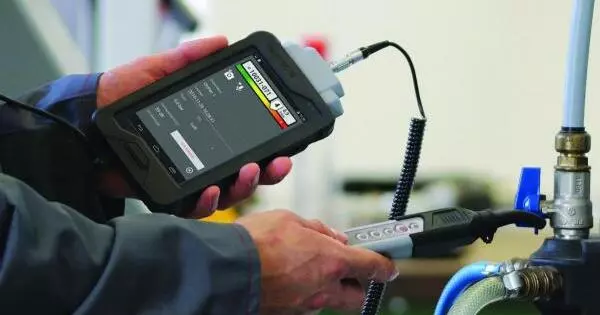Leaks can be a significant source of wasted energy in an industrial compressed air system, wasting up to 30% of the output of a compressor. A typical poorly maintained plant will have a leak rate equal to 20% of total compressed air production capacity. Proactive leak detection and repair, on the other hand, can reduce leaks to less than 10% of compressor output.
Southwest Research Institute (SwRI) has created a proof-of-concept system that can detect compressed air leaks on trains and relay their location to mechanical personnel for repair. The automated system has the potential to reduce the time, cost, and labor required to locate and repair air leaks, as well as the locomotive industry’s overall fuel consumption and exhaust emissions.
Compressed air is used in trains for a variety of purposes, including air brakes, valve actuation, radiator shutters, horns, and bells. Each year, the rail industry is estimated to lose between 2-3% of vehicle efficiency due to air leaks that occur at various points throughout trains. Furthermore, these leaks can have a negative impact on train operability and safety.
“Air leaks significantly increase fuel consumption and reduce the effectiveness of a locomotive’s automatic engine stop-start (AESS) systems, causing locomotives to run more frequently, burn more fuel, and shorten the lifespan of parts like starters, air compressors, and batteries,” SwRI Lead Engineer Christopher Stoos explained. “We’re talking about potentially saving millions of gallons of fuel and lowering emissions of carbon dioxide, nitrogen oxides, and particulate matter.”
Air leaks significantly increase fuel consumption and reduce the effectiveness of a locomotive’s automatic engine stop-start (AESS) systems, causing locomotives to run more frequently, burn more fuel, and shorten the lifespan of parts like starters, air compressors, and batteries.
Christopher Stoos
Currently, finding air leaks requires railroad employees to manually search for them, often going on, under or between railway vehicles to listen or feel for leaks. The practice is inefficient, time-consuming and introduces unnecessary risk to mechanical staff. Knowing this, the Federal Railroad Administration and railroads have outlined acceptable air leak rates for trains.
To significantly reduce these leaks, SwRI has created a system that uses audio detection technology, cameras, and machine learning to autonomously detect, identify and report air leaks, even on moving trains.
The project is funded by the Transportation Research Board’s (TRB) Rail Safety IDEA program and led by Stoos, Senior Research Engineer Heath Spidle and Research Engineer Jake A. Janssen.

The system employs a small, commercially available Fluke SV600 fixed acoustic imager with a 64-microphone array and camera tuned to detect frequencies of 30-45kHz, which are the frequencies at which compressed air leaks best distinguish themselves from most background noise. This device works in conjunction with a secondary visual spectrum camera. The team trained and implemented machine learning algorithms to identify air leaks from sensor outputs while ignoring non-leak-related outputs to automate the detection process.
During testing, the prototype system successfully detected a range of air leaks at various locations on locomotives with a false positive rate of only 0.03%. The system detected, on average, 11 out of every 13 leaks on a moving train. Once an air leak was identified, an alert with an accompanying image was shared electronically with appropriate personnel showing the area in need of inspection and repairs.
“The system should reduce the burden on mechanical personnel while improving the performance of the compressed air system,” Stoos said. “More field development and testing is required, but if implemented correctly, this system has the potential to save the locomotive industry millions of dollars in fuel savings and maintenance. By improving locomotive fuel efficiency, this technology has the potential to significantly reduce greenhouse gas emissions.”
Compressed air, gas, and vacuum systems are critical sources of converted energy for industrial plants and facilities. Compressors are ubiquitous in today’s factories because they are less expensive than other resources such as electricity. They operate machines, tools, robotics, lasers, product handling systems, and other equipment.
















